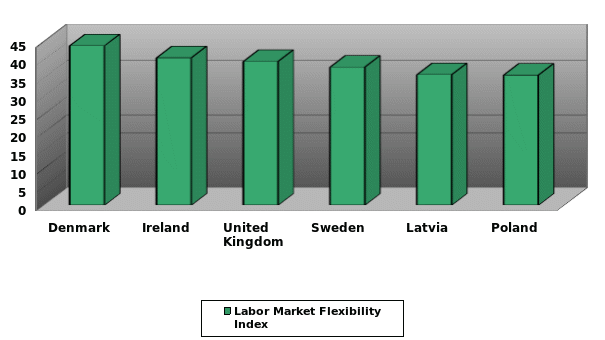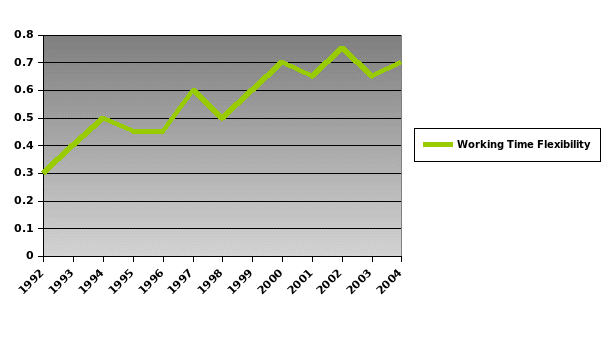Introduction: What is Flexibility?
Flexibility can be defined as the ability of a firm to respond to a plethora of changes in both internal and external environment promptly. From managerial perspective, flexibility can refer to responsiveness of the overall organisational structure to both challenges and opportunities presented in the competitive environment (Nandakumar et al. 1). At the same time, from employees’ point of view, it may rather refer to autonomy in performing professional tasks and roles, as well as the overall adjustability of operational processes to individual interests and ways of work. Modern scholars distinguish several types of organisational flexibility including numerical, internal, external, functional flexibility, and so on (Kozjek and Ferjan 4). In the given paper, the focus will be made on temporal and locational flexibility modes.
Temporal and Locational Flexibility
The term “temporal flexibility” implies “the variation in the numbers of hours worked and the timing of the work” (“Temporal Flexibility”). It primarily refers to scheduling practices and employee workloads and may usually take such forms as overtime, flexi-time, seasonal and annual contracts, self-scheduling, and so on. The major advantage of the given flexibility model is that it helps to align organisational needs with employees’ interests by allowing a better combination of work and private life (Possenriede et al. 1). At the same time, locational flexibility implies that a person can work remotely. Telehomework is a common practice associated with the given model (Possenriede and Plantenga 2). It is also meant to make employees’ working hours as comfortable as possible and adjusted to their preferred lifestyles. However, it may be associated with such disadvantages as the inability to interact with employees directly, monitor and instruct them, and develop close employer-subordinate relationships (Possenriede 2).
Statistical Data: UK
Workplace flexibility practices are crucial to business survival and competitiveness at the microeconomic and macroeconomic level as they help attract and retain talented personnel (Whyman and Petrescu 776). In the United Kingdom, the flexible labour market is one of the best in Europe. The overall index of labour flexibility in the United Kingdom is 39,58 compared to 40,55 in Ireland and 43,88 in Denmark (Tebbit 30). The average temporal flexibility equals 31,27 compared to 35,07 in Poland and 35,49 in Italy (Tebbit 30). Additionally, over 50% of all UK employees report working outside main offices for about 2-3 days a week, while only 36% work at remotely full-time (“The Workplace Revolution”).

UK Trends in Workforce Flexibility
By developing and promoting obligatory policies in this area of performance, the UK government aims to “hamper labour mobility, reduce the dynamic efficiency of the economy and restrain job creation” (Tebbit 23). The statistical data shows that temporal and locational workplace flexibility has dramatically increased since 1992 in the United Kingdom and, according to Tebbit, the rise is mainly defined by increased immigration rates (26).

Atkinson’s Flexible Firm Model
In the situation of sustained unemployment and slower economic growth, organisations can apply various flexibility models including Atkinson’s Flexible Firm Model (FFM), which aims to remove the rigidity created by strict management and control rules and adjust organisational processes to unfavourable conditions. The FFM is based on creating a core and peripheral workforce, whereas the core workforce is comprised of highly skilled workers “able to participate in decision making and are directly employed by an organisation;” who are provided with job security and high salaries that “reflect skill level and their importance to the organisation” (Dyer 107). At the same time, the peripheral workforce is characterised by “low wages, low job security and having little or no autonomy in their work” (Dyer 107). When applying the given model to temporal and locational flexibility, the work hours for core personnel will rather be adjusted to product and service requirements (i.e., the quantity and quality of outputs), and part-time and flexi-time scheduling may be appropriate in this case. When speaking of the peripheral workforce, it is associated with numerical flexibility, i.e., the management can modify the number of employees and the quantity of their input by using such practices as short-term contracts, homework, etc.
Examples
Many UK organisations employ various flexibility models to maintain employees’ well-being and increase productivity. For instance, Sweaty Betty, a medium size enterprise founded in 1998 in London and specialising in athletic apparel, uses flexi-hours policy allowing employees to start working between 8 am and 10 am (Sweaty Betty). It means that employees are provided with some degree of autonomy, yet are required to work a certain amount of hours. However, the benefit of the given strategy is that it helps Sweaty Betty to reduce stress in subordinates by allowing them to balance their family and work lives. Another example is Microsoft where a large part of employees (about 64%) work remotely (Courtois). To ensure high-level productivity of remote workers, the company supplies them with all the necessary connectivity tools including laptops and smartphones (Courtois). What is more important is that to make the given strategy work, the company created a unique employee communication environment based on trust. Such an approach allows Microsoft increase employee commitment and retention.
Conclusion
Overall, there are many ways to make the organisation more flexible. The utilisation of temporal and locational flexibility models is only one of the possible solutions. Any flexibility workplace model can provide significant benefits for both employers and employees. However, it is also associated with some risks. As the literature review reveals, to mitigate and manage those threats, a supporting technological, structural, and cultural environment is required.
Works Cited
Courtois, Jean-Philippe. “Microsoft’s New World of Work is All About People.” BBC, 2012, Web.
Dyer, Suzette. Flexibility Models: A Critical Analysis. 2017. Web.
Kozjek, Tatjana, and Marko Ferjan. “Organizational Flexibility, Employee Security, and Organizational Efficiency – a Case Study of Slovenian Public and Private Sector Organizations.” Organizacija, vol. 48, no. 1, 2014, pp. 3-22.
Nandakumar, M. K. et al. Organisational flexibility and competitiveness. Springer, 2014.
Possenriede, Daniel, and Janneke Plantenga. Temporal and Locational Flexibility of Work, Working-Time Fit, and Job Satisfaction. 2014, Web.
Possenriede, Daniel, et al. “Does Temporal and Locational Flexibility of Work Increase the Supply of Working Hours? Evidence from the Netherlands.” IZA Journal of Labor Policy, vol. 5, no. 1, 2016, pp. 1-34.
Possenriede, Daniel. Temporal and Locational Flexibility of Work and Absenteeism. 2012, Web.
Sweaty Betty. “5 Reasons Sweaty Betty Has Britain’s Healthiest Employees.” Sweaty Betty, 2015, Web.
Tebbit, Alistair. Does the UK Still have a Flexible Labour Market? 2017. Web.
“Temporal Flexibility.” Oxford Reference, 2017, Web.
“The Workplace Revolution − A Picture of Flexible Working 2017.” Regus, Web.
Whyman, Philip,B., and Alina Ileana Petrescu. “Workforce Nationality Composition and Workplace Flexibility in Britain.” International Journal of Manpower, vol. 35, no. 6, 2014, pp. 776-797.